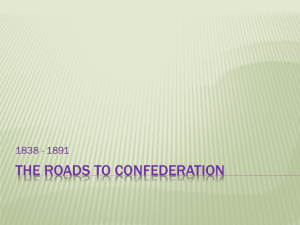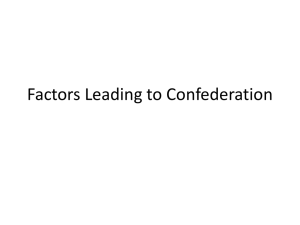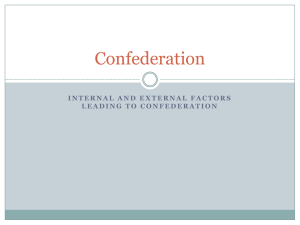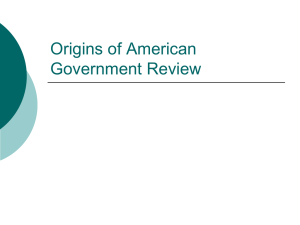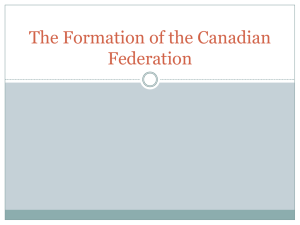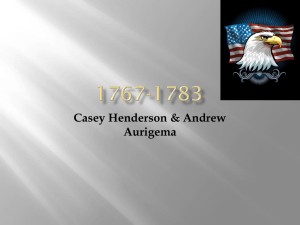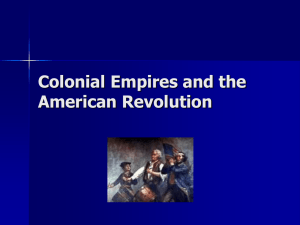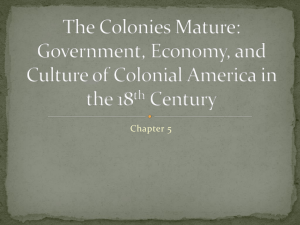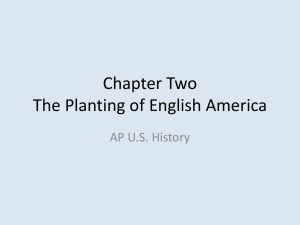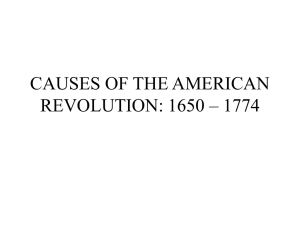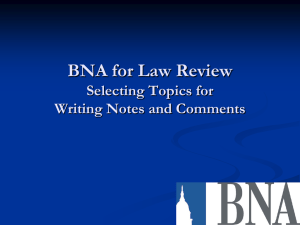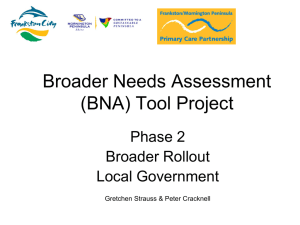Confederation
advertisement
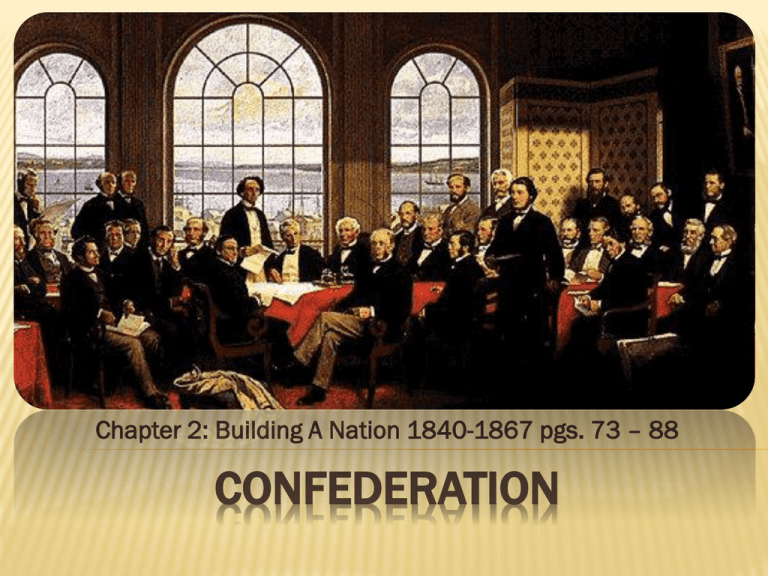
Chapter 2: Building A Nation 1840-1867 pgs. 73 – 88 CONFEDERATION BUILDING A NATION Politicians dreamed of Confederation, a union of the BNA colonies into a federation (division of powers btwn central govt and local govt). It took many deals and compromises for it to become a reality. 1846 – BRITAIN REPEALED THE CORN LAWS The Corn Laws gave trading privileges to Britain’s colonies But Britain wanted to move towards Free Trade Britain now bought goods where they were cheapest The cancelling of the Corn Laws left Canada in a depression. A period of low economic activity and high unemployment. Thus, Canada started looking towards creating its own country. 1847 - LORD ELGIN BECOMES GOVERNOR Sent by Britain with the task of putting Responsible Government into operation. Colony would become Britain’s economic partner, not Britain’s responsibility. Advantageous to Britain b/c it was expensive to govern, defend and financially support the colonies. 1849 – REBELLION LOSSES BILL Government of Canada passed a bill giving financial compensation to anyone, including the rebels who lost property during the Rebellions of Upper and Lower Canada. Reaction: Anti-Rebel forces were outraged Lord Elgin was outraged – but powerless (No Veto) Treason seen as being rewarded Violence erupts – riots, Elgin’s carriage attacked, and … PARLIAMENT BUILDING’S BURNT DOWN Elgin’s signature marked the beginning of a new form of government in Canada RESPONSIBLE GOVT FILM CLIP CONFEDERATION: THE CREATION OF CANADA Advantages: Disadvantages: SIX FACTORS LEADING TO CONFEDERATION The Pressure Points: 1. Need for Rail Links 2. War and Expansionism in the US 3. Fenian Raids 4. Trouble with Trade 5. Changing British Attitudes 6. Political Deadlock #1 RAILWAY LINKS A railway linking the colonies was needed to increase trade and to move troops for defence. Travel by water was slow and rivers froze in the winter Railways made it possible to get farm crops and manufactured goods to market quickly and cheaply. Vital importance to the economy of Canada If the colonies joined together they all shared in the costs of an Intercolonial Railway. #2 WAR AND EXPANSIONISM OF USA American Civil War (1861 – 1865) The Northern and Southern American states were at war with one another Britain supported the South In the end, the Northern states accused the British colonies of helping the Southerners There was talk of invading BNA colonies #2 WAR AND EXPANSIONISM OF USA MANIFEST DESTINY: the idea that the destiny of the US was to include all of BNA As a result, Canadians were very suspicious of US intentions Scattered BNA colonies had weak defences against the Americans BUT – as a UNITED and INDEPENDENT nation, the US would be less likely to invade. “As fragments, we shall be lost; but let us be united and we shall be a rock.” - Thomas D’Arcy McGee (Canada East) “If we desire to obtain England’s support for our defence, we must help ourselves. When we are united, the enemy will know that if he attacks any province he will have to deal with the combined forces of the Empire.” - George-Etienne Cartier (Canada East) #3 FENIAN RAIDS The Fenian Brotherhood started in Ireland to promote armed rebellion against British rule. The Irish resented British rule and occupation and still blamed Britain for the Potato Famine. When the rebellion in Ireland failed, the Fenians in American planned to harm Britain by striking at Canada. Some Fenians believed that a takeover of Britain’s North American possessions would force Britain to negotiate freedom for Ireland. #3 FENIAN RAIDS The Fenians never mounted more than small border raids Although small in scale, the invasions and resulting rumours had a major impact. The Fenian attacks convinced many that the US threat to Canada was real. Macdonald used the raids to his political advantage in developing support for his dream of Confederation #4 TROUBLE WITH TRADE Repealing of the Corn Laws Cancellation of the Reciprocity Treaty Britain entered a period of free trade (trade between countries w/o taxes involved) BNA colonies lost their special trade relationship with Britain Result: Economic hard times. In 1865 limited free trade ended between BNA and the USA New idea amongst the BNA colonies – if the colonies joined together among themselves, removing the tariffs(taxes) btwn colonies, economic prosperity would continue. #5 CHANGING BRITISH ATTITUDES Great Britain wanted her colonies to be more self-sufficient. Colonies were too expensive to govern, defend, and support financially. British governors in each colony were told to encourage colonies to unite. #6 POLITICAL DEADLOCK Under the Act of the Union, Canada East and West had an equal number of representatives in the Legislative Assembly. Members from French and English provinces rarely agreed on an issue, since what was good for French Canada invariably hurt English Canada, and vice versa. One group often voted against the other and no legislation would pass political deadlock Canada West wanted “rep by pop” Since Canada West was larger, they would have more representatives in the Legislative Assembly. CANADA EAST Parti Rouge (radicals) Led by Louis-Joseph Papineau Supported French-speaking farmers & business people Hated Act of the Union Parti Bleu Led by George-Etienne Cartier Focused on the economic development of Canada and protection of French-Canadian rights Wide support in the province and in government Prepared to work with Canada West to achieve its goals CANADA WEST Clear Grits (radicals) Led by George Brown Defended English-Canadian interests Disliked Catholics and French Supported “rep by pop” Tories (moderate) Led by John A. Macdonald Made a deal with the Parti Bleu to combine and form a government Strong proponent of Confederation with a strong central government #6 POLITICAL DEADLOCK Confederation was seen as a way to break the impasse. It would be more beneficial to give each colony their own provincial governments to legislate matters of provincial interest. The Political Deadlock lead to the Great Coalition in the United Province of Canada called the Confederation Party. The purpose: to create a federal union in the Province of Canada and to seek a larger union with the other BNA colonies. The members of this union would retain some powers over their own affairs and would turn some powers over to a more powerful central government. THE CONFERENCES Canadian confederation was actually more “deal” than “ideal.” Why? A series of meetings took place where representatives from all the colonies hammered out the details of a new union. 1. 2. 3. Charlottetown Conference, 1864 Quebec Conference, 1864 London Conference, 1866 CHARLOTTETOWN CONFERENCE The meetings began in 1864 in Charlottetown, PEI, where the Maritime colonies planned to discuss a Maritime union. Members of the Great Coalition joined the meeting Discussion of a Maritime union was replaced with Canada’s proposal for a BNA federation QUEBEC CONFERENCE Planned the birth of a new nation Difficult, time consuming, and much discussion, and much disagreement. OUTCOME: Provincial governments will retain many powers nation would become a federation. Produced Seventy-Two Resolutions – statements on government Each colony had to debate and approve the legislation by their own legislature. In the end, Nova Scotia, New Brunswick and Canada decided to join together as one nation, and to ask Britain for permission. LONDON CONFERENCE, 1866 In London, England the British Parliament passed the British North American Act, creating the Dominion of Canada on July 1st 1867. BNA ACT: CANADA’S CONSTITUTION The BNA Act became Canada’s constitution the laws that outline the powers and responsibilities of the government as well as guarantee the rights of the people DISTRIBUTION OF POWER Federal •Postal Service •Defence •Regulation of Trade and Commerce •Navigation and Shipping •Coinage and Currency •Fisheries Provincial •Education •Administration of Justice •Maintenance of Hospitals •Timber •Prisons What responsibility do the Provincial and Federal government share? taxation HOMEWORK Many internal and external factors led to the achievement of Confederation. Choose either internal or external factors and write a well-developed paragraph explaining how it led to the achievement of confederation. Double space! Due Next Class
